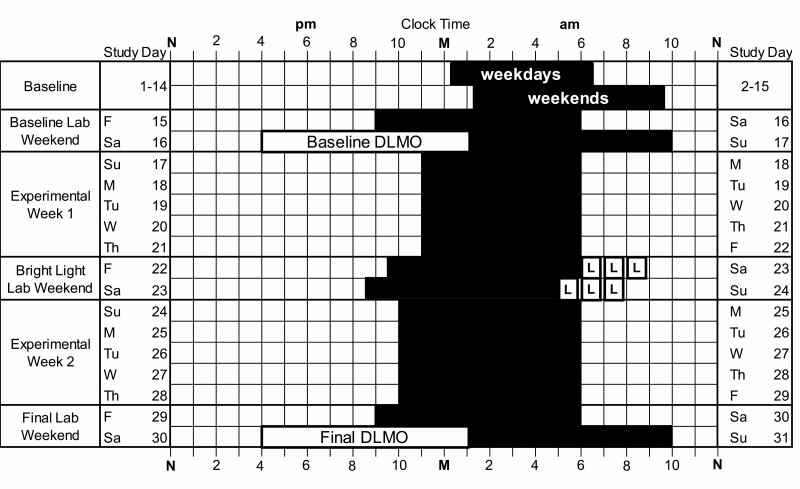Figure 2.
Example protocol for intervention participants. M, midnight; N, noon. Black rectangles illustrate dark/sleep. Participants had two baseline weeks of usual sleep at home (days 1–14). Average baseline sleep onset and wake-up times on weekday and weekend nights are shown. Then, participants lived in the laboratory for a weekend (Baseline Lab Weekend). On Friday–Saturday (study days 15–16), a 9-h sleep opportunity was timed to end at the individual’s average school-day wake-up time. Dim light melatonin onset (DLMO) was measured on Saturday (day 16) via serial saliva sampling every 30 min starting at 1600 and ending at the individual’s average weekend bedtime (± 30 min). Participants were given a 9-h sleep opportunity in the laboratory after the DLMO phase assessment. During Experimental Week 1 (days 17–21), participants in the intervention group were instructed to go to bed and try to fall asleep 1 h earlier than their average baseline school-night sleep onset. Individualized behavioral goals (“Sleep RouTeen”) were identified for each participant to help them manage their time in the evening and facilitate earlier bedtimes during this week. Then, intervention participants lived in the laboratory for another weekend (Bright Light Lab Weekend, days 22–24) to receive 2.5 h intermittent bright light (three 50-min exposures with 10-min breaks between) from light boxes (~6000 lux) on both mornings to advance circadian rhythms. During Experimental Week 2 (days 24–28), assigned bedtime was shifted an additional 1 h earlier than Experimental Week 1 and the “Sleep RouTeen” behavioral goals continued to be reinforced. A Final Lab Weekend occurred on days 29–31 and was the same as the Baseline Lab Weekend. Control participants completed the same protocol as the intervention participants, except they continued to sleep as usual at home for both Experimental Weeks, did not receive the “Sleep RouTeen” behavioral goals, and did not participate in the Bright Light Lab Weekend.

